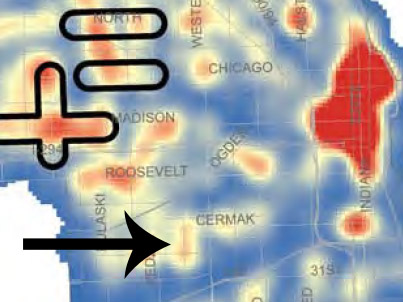Last night, 38-year-old Nikkii Bostic-Jones—a Cook County correctional officer, wife, and mother of a six-year-old—was killed in a hit-and-run at 29th and California, not far from her job at 26th and California. It's tragic, but not shocking; Chicago has an inexplicably high number of fatal hit-and-run crashes.
The reason this was a hit-and-run is not a mystery: "she was hit by a navy-blue van with stolen license plates and knocked into the path of a sheriff's squad car." The area around the jail is also a moderately high-pedestrian-crash corridor:

There's a lot of foot traffic in the vicinity of the jail, and in my experience people tend to drive fast south of it, with low-density neighborhood giving way to the constant comings and goings around the jail.
Chicago has experienced a number of fatal hit-and-runs this year. A five-year-old girl was killed by a hit-and-run driver on July 2nd in North Lawndale, one of the top ten community areas for fatal and serious injury crashes from 2005-2009—the third most, behind the Loop and Englewood. Last Thursday, a 23-year-old woman was killed at 87th and Cottage Grove, by a driver with a suspended license.
The city's percentage of hit-and-run crashes seems to be in line with other large cities: between 2005 and 2009, it was 33 percent, comparable to Los Angeles's figures. It's fatal hit-and-run crashes where the city has a serious problem: 41 percent of all fatal crashes in that time period were hit-and-run crashes, twice the average for New York and nationwide. Steven Vance has been keeping track of fatal crashes versus fatal hit-and-run crashes, and adding Bostic-Jones's death to his post yesterday, that should make seven hit-and-run pedestrian fatalities out of nine total pedestrian fatalities this year.
Vance has looked deeper into the issue, and is as perplexed as I am. Obviously traffic calming measures can prevent crashes from occurring, but once those crashes do occur, then it's a matter of the driver, a problem that can't just be solved with engineering. A recent paper out of Berkeley's Safe Transportation Research and Education Center looks at predictive factors for fatal hit-and-run drivers (which should be taken with a grain of salt, the authors note, because a lot of hit-and-run drivers are never caught), and they shouldn't be surprising:
Hit-and-run drivers were more likely to be male, have prior violations, suspension, and an older vehicle and less likely to have a valid driver’s license (Tables 1 and 2). In the adjusted model where the driver was identified (Table 2), young age (≤25 years), positive blood alcohol content (<0.10 and ≥0.10), and prior DWI significantly increased the risk of leaving the scene 1.8, 3.9, 1.8, and 1.8 times respectively.
Hit-and-run crashes sit at the border between traffic engineering and law enforcement, and like all social problems that sit between civic categories, it's more complicated than one that's either/or.



